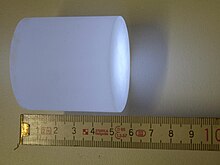Scintillator

A scintillator is a body, the molecules of which are excited by collision processes when high-energy photons or charged particles pass through them and which emit the excitation energy again in the form of light (mostly in the ultraviolet or visible range). This process is called scintillation (from Latin scintillare : 'sparkle', 'flicker').
introduction
The effect is mainly used in scintillation counters to measure the energy and intensity of ionizing radiation . The energy deposited in the scintillator of each individual collision process results from measuring the amount of light (e.g. with a photomultiplier or a photodiode ), the intensity (the flow of particles or quanta) from the number of scintillations per unit of time.
Free neutrons can also be detected indirectly , namely via the charged particles that move through the scintillator due to the recoil after scattering processes or that are released during nuclear reactions of the neutron in the scintillator material (see neutron detector ).
The word scintillator can designate the relevant material or the finished device part.
There are organic and inorganic scintillators. They have different scintillation mechanisms.
Inorganic scintillators
Inorganic scintillators are crystals with activator centers doped are. Ionizing radiation generates free electrons , free holes or electron-hole pairs ( excitons ) in this solid . Such excited states migrate in the crystal lattice until they encounter an activator center. The activator center is now excited and returns to its basic state with the emission of visible light ( photons ). The ionization loss of the particles determines how many photons are generated in the crystal.
In order for the scintillator to be sufficiently transparent to its own light, it must generally be a single crystal .
Examples: bismuth germanate , lead tungstate , lutetium oxyorthosilicate , sodium iodide , zinc sulfide , cesium iodide
Organic scintillators
Organic scintillators can be crystals , liquids or polymer solids . The mechanism of scintillation is based on the excitation of molecular states in a primary fluorescent substance, which emit UV radiation when they decay . A second fluorescent material, e.g. B. the " wavelength slider " POPOP , must be added to the scintillator, since UV radiation has a very short range in most transparent materials. Polyethylene naphthalate has recently been discovered as a primary fluorescent substance with good yields in the visible wavelength range, which suggests a significant reduction in the price of organic scintillators.
In the case of liquids as scintillators, a distinction must be made between
- Liquid scintillation counters in which the substance to be measured (a low-energy beta emitter) is in a solution together with the scintillator, and
- Liquid scintillators for measuring fast neutrons. Such a scintillator, enclosed in a fused glass vessel or metal vessel with a glass window, is used like a solid scintillator. These scintillators offer the advantage that the pulses originating from gamma radiation can be distinguished from the neutron pulses by electronic means (pulse shape discrimination).
commitment
Scintillators are widely used in basic research, but also in areas such as radiation protection and radiation medicine. In particle physics , for example, they are used in calorimeters - together with other materials such as wavelength sliders . With the ever higher energies and intensities of the particle beams, the demands on quality , complexity and radiation resistance of the scintillator materials also increase. Some detector designs require special calibration efforts because LaBr scintillators, for example, have a non-linear response. Otherwise, scintillators are used in theoretical models for energy generation, in which they "convert" gamma radiation into lower-energy photons, which could be further used via the photovoltaic effect.
Web links
- Stephan Paul, Wolfram Weise: Scintillation. In: online script particles and nuclei. August 10, 2005, archived from the original on July 6, 2007 .
Individual evidence
- ↑ A. Dannemann: Investigations into the radiation resistance of polymer materials for use in experiments in high-energy physics , dissertation, Department of Physics at the University of Hamburg , 1996, internal report: DESY F35D-96-06 (PDF; 5.8 MB), accessed on 8. June 2013.
- ↑ W. Busjan: Radiation resistance of scintillating synthetic fibers in high-energy physics: Formation and decay of short-lived absorption centers . Dissertation, Department of Physics, University of Hamburg , 1997.
- ↑ B. Casey, K. DeVaughan, Y. Enari, R. Partridge, S. Yacoob, Radiation Damage to Scintillator in the DØ Luminosity Monitor , Internal Report FERMILAB-CONF-06-469-E , (PDF; 0.9 MB ), accessed June 26, 2013.
- ↑ Alexander Blecher: High energy calibration of scintillating detectors with thermal neutrons . GRIN Verlag, Darmstadt 2015, ISBN 978-3-668-07839-0 , p. 3 .
- ↑ JK Liakos, Gamma-Ray-Driven Photovoltaic Cells via a Scintillator Interface , Article , (PDF; 0.4 MB), accessed on December 1, 2019.